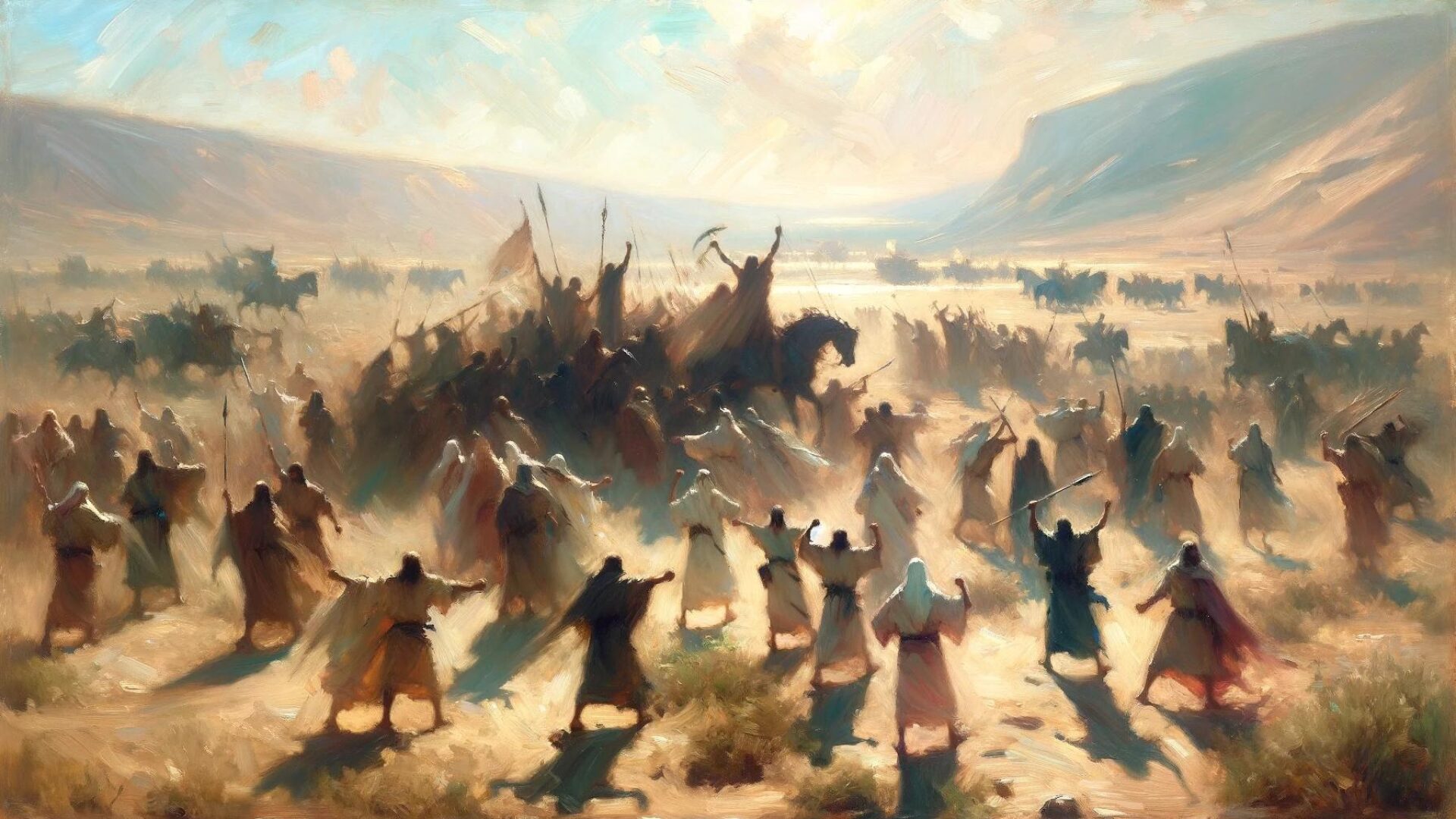The Bible is a rich source of religious and historical insights. The plagues of Egypt, mentioned in the Book of Exodus, and the prophecies in the Book of Revelation, are two significant events with a profound impact on biblical history and interpretation. In this article, we will conduct an in-depth analysis of the plagues of Egypt compared to Revelation, exploring the similarities and differences, and discussing their possible religious significance.
By comparing these events, we can gain a deeper understanding of biblical prophecy, divine judgment, and the symbolic meaning behind such occurrences. Moreover, understanding the relevance of these events in modern times can help us interpret and apply the teachings of the Bible to our daily lives.
The Ten Plagues of Egypt: A Divine Judgment
The plagues of Egypt are among the most well-known biblical events, providing a fascinating insight into the divine judgment of God.
As described in the Book of Exodus, the ten plagues were sent by God to punish Pharaoh and the Egyptian people for their refusal to release the Israelites from slavery. Each plague was specifically designed to demonstrate the power of God and to serve as a warning to those who would oppose Him.
The ten plagues were as follows:
| Plague | Description |
|---|---|
| Water turned to blood | All water in Egypt turned to blood, causing fish to die and making it undrinkable. |
| Frogs | Frogs covered the land of Egypt, entering homes and affecting daily life. |
| Gnats or lice | Gnats or lice infested the Egyptians and their animals, causing great discomfort. |
| Flies | Flies swarmed the land and entered the houses of the Egyptians, causing chaos. |
| Death of livestock | All livestock belonging to the Egyptians died suddenly. |
| Boils | Boils afflicted the Egyptians and their animals, causing great pain. |
| Hailstorm | Hailstones rained down on the land, destroying crops and causing damage. |
| Locusts | Locusts swarmed the land, eating all remaining crops and vegetation. |
| Darkness | A thick darkness covered the land for three days, causing fear and uncertainty. |
| Death of firstborn | The firstborn children of the Egyptians died, sparing only those who followed the instructions given by God. |
It is important to note that the plagues were not only a punishment for the Egyptians but also a demonstration of God’s power and a means of protecting His people, the Israelites. Each plague built on the previous one, increasing their severity and sending a clear message to Pharaoh and the Egyptians.
The ten plagues of Egypt serve as a reminder of the power and justice of God, and their significance continues to be studied and debated to this day.
The Book of Revelation: A Glimpse into the End Times
The Book of Revelation is the final book of the New Testament and the Bible, written by John of Patmos. It is filled with prophetic visions and symbols, unveiling the final events of the world and the second coming of Jesus Christ.
The apocalyptic themes in the Book of Revelation have fueled debates and discussions for centuries. The book is complex and often requires careful interpretation to fully uncover the meanings behind the prophetic imagery. Its message has been interpreted in many ways, ranging from literal interpretations to more symbolic and metaphorical ones.
The Book of Revelation is one of the most challenging biblical texts to understand, yet it is significant in understanding end times prophecy. Its themes and symbols have influenced many people and movements throughout history, inspiring art, literature, and theology.
Comparing the Plagues: Similarities and Differences
When comparing the plagues of Egypt to the prophecies in Revelation, there are both similarities and differences to take into account. Both sets of events are biblical, and both are associated with divine intervention and judgment. Here, we will examine some of the similarities and differences between the plagues of Egypt and the prophecies in Revelation.
The Ten Plagues of Egypt vs. The Seven Seals, Trumpets, and Bowls
One of the most obvious differences between the plagues of Egypt and the prophecies in Revelation is the number of events. The plagues of Egypt are ten in number, while the prophecies in Revelation are divided into seven seals, seven trumpets, and seven bowls. Additionally, the plagues of Egypt were limited to the nation of Egypt, while the events in Revelation are described as affecting the entire world.
Symbolic Imagery
Another similarity between the plagues of Egypt and the prophecies in Revelation is the use of symbolic imagery. The plagues of Egypt were not just physical events that caused harm and destruction, but also carried symbolic meaning. For example, the plague of darkness could be interpreted as representing spiritual darkness and the plague of the firstborn, the condemnation of sin. Similarly, the events in Revelation are filled with symbolic imagery such as the four horsemen of the apocalypse, which are thought to represent war, famine, death, and conquest.
Theological Significance
Both the plagues of Egypt and the prophecies in Revelation have theological significance as well. The plagues of Egypt, for example, were a manifestation of God’s power and justice, and were intended to demonstrate the supremacy of the God of Israel over the gods of Egypt. In the case of the events in Revelation, they are often interpreted as a warning of the end times and a call to repentance. The prophecies are also seen as evidence of the sovereignty of God and his ultimate triumph over evil.
Overall, while there are some similarities between the plagues of Egypt and the prophecies in Revelation, there are also significant differences. However, both sets of events are crucial to understanding the biblical narrative and the nature of God’s relationship with humanity.
The Symbolic Meaning Behind the Plagues and Revelation
The plagues of Egypt and the prophecies in the Book of Revelation are not just historical events or predictions of future disasters. They are also filled with symbolism and prophetic imagery that reveal deeper spiritual truths about God and humanity. In this section, we will explore some of the symbolic meanings behind these biblical events.
The Significance of Numbers
Numbers are significant in both the plagues of Egypt and the Book of Revelation, and they often carry symbolic meanings. For example, the number 10 in the 10 plagues of Egypt represents completeness or fullness. Each plague was a judgment against one of the Egyptian gods, demonstrating God’s complete power over the false gods of Egypt.
In the Book of Revelation, the number 7 is significant as it represents perfection or completeness. There are 7 churches, 7 spirits, 7 seals, 7 trumpets, and 7 bowls. The repetition of this number emphasizes the completeness and perfection of God’s plan for humanity’s redemption.
The Symbolism of Animals
Both the plagues of Egypt and the Book of Revelation use animals as symbols of power and judgment. In the plagues of Egypt, various animals such as frogs, flies, and locusts were used to bring judgment upon the Egyptians. These animals were often associated with Egyptian gods and represented a challenge to their power.
In the Book of Revelation, animals such as the lamb, the lion, and the serpent are used to represent spiritual realities. For example, the lamb symbolizes Christ as the sacrificial lamb, while the lion represents Christ’s power and kingship. The serpent, on the other hand, represents Satan and temptation.
The Imagery of Light and Darkness
Light and darkness are powerful symbols used throughout the Bible to represent good and evil, truth and falsehood. In the plagues of Egypt, darkness was used as a symbol of judgment against Pharaoh and the Egyptians’ refusal to acknowledge the true God. In the Book of Revelation, darkness is associated with the reign of Satan and his influence over the world.
Conversely, light is a symbol of God’s presence and truth. In the Book of Revelation, Christ is described as the “light of the world” and as having a face “like the sun shining in its strength.”
The symbolic meanings behind the plagues of Egypt and the Book of Revelation are just a few examples of the power and richness of biblical imagery. Through the use of symbols and prophetic language, God communicates profound truths about himself, the world, and humanity, inviting us to participate in the story of redemption.
The Relevance of Plagues and Prophecies in Modern Times
The comparison between the plagues of Egypt and the prophecies in the Book of Revelation is not only a theological and spiritual exercise but has also been relevant in various modern interpretations. Many see the plagues in Egypt as a warning of God’s judgment against sin and disobedience. Similarly, the plagues depicted in Revelation are believed to be a warning to humanity of the imminent end times.
Some modern scholars view the plagues and prophecies through the lens of contemporary events and issues. For example, some see the COVID-19 pandemic as a modern-day plague, drawing parallels to the plagues in Egypt. Others interpret the prophecies in Revelation as warnings about the devastating effects of climate change and environmental degradation.
Moreover, the symbolic meaning of the plagues and prophecies resonates with many today. The imagery of locusts, darkness, and death in the plagues of Egypt and the beasts, dragons, and angels in Revelation continue to capture the imagination of people worldwide. The use of symbols and metaphors to convey spiritual truths and warnings speaks to our need for deeper reflection and understanding of the world around us.
The relevance of the plagues and prophecies in modern times extends beyond the religious and theological spheres. The symbolic and metaphorical aspects of these events have inspired artists, writers, and filmmakers, creating a rich cultural legacy that endures to this day.
Overall, the plagues of Egypt and prophecies in Revelation have not lost their relevance in modern times. From climate change to pandemics, their warnings and messages continue to resonate with people across different cultures and belief systems. The use of symbolism and metaphor in conveying spiritual truths also remains a powerful tool for reflection and understanding.
Conclusion
Comparing the plagues of Egypt to the prophecies in the Book of Revelation has provided us with a deeper understanding of biblical events and their significance. We have explored the ten plagues of Egypt as divine judgments and the apocalyptic themes of the Book of Revelation. We have also discussed the similarities and differences between these events and their symbolic meanings.
As we reflect on the modern relevance of these events, we can see how the biblical interpretations and perspectives have evolved over time. While some may view these events as literal history, others may see them as symbolic representations of spiritual truths. Regardless of the perspective, these events continue to offer insights and lessons that can be applied to our lives today.
The Significance of Comparison
The comparison of the plagues of Egypt to the prophecies in Revelation is significant because it highlights the continuity of biblical themes throughout history. We can see the progression of divine judgment and apocalyptic visions that ultimately lead to the ultimate victory of good over evil.
While the events of these two books may seem vastly different, their comparison reveals the unity of biblical prophecy and the timeless nature of God’s message to us. As we continue to explore the Bible, we can gain a deeper appreciation for the spiritual insights that can be gained from these ancient texts.
Final Thoughts
As we conclude our analysis of the plagues of Egypt and the prophecies in Revelation, we can see that these events offer much more than mere historical accounts. Their symbolic meanings and spiritual insights provide us with a deeper understanding of God’s plan for humanity and the ultimate victory of good over evil.
May this comparison inspire us to continue our exploration of biblical themes and to seek greater understanding of God’s message to us.
FAQ
Q: What is the significance of comparing the plagues of Egypt to the prophecies in the Book of Revelation?
A: By comparing the plagues of Egypt to the prophecies in Revelation, we can gain a deeper understanding of biblical events and their symbolic meaning. This comparison allows us to explore themes of divine judgment and apocalyptic themes in both the Old and New Testaments.
Q: What are the ten plagues of Egypt and their role as divine judgments?
A: The ten plagues of Egypt, as described in the Book of Exodus, were a series of catastrophic events sent by God as divine judgments upon Pharaoh and the Egyptians. These plagues included turning the Nile River into blood, infestations of frogs, gnats, and insects, the death of livestock, boils, hailstorms, locusts, darkness, and the death of the firstborn.
Q: What is the Book of Revelation and its role in understanding end times prophecy?
A: The Book of Revelation is the final book of the New Testament, which provides a prophetic vision of the end times. It offers insights into the events leading up to the Second Coming of Christ, the battle between good and evil, and the ultimate establishment of God’s kingdom. Understanding Revelation is crucial in comprehending biblical end times prophecy and its significance in Christian theology.
Q: How do the plagues of Egypt and the prophecies in the Book of Revelation compare?
A: Comparing the plagues of Egypt and the prophecies in the Book of Revelation reveals both similarities and differences. Both depict divine judgments, symbolize the struggle between God and evil forces, and serve as reminders of God’s power and authority. However, they differ in the historical context, the specific events described, and their overall purpose in the biblical narrative.
Q: What is the symbolic meaning behind the plagues of Egypt and the prophecies in the Book of Revelation?
A: The plagues of Egypt and the prophecies in Revelation contain deep symbolic meaning. They use vivid imagery and symbolism to convey spiritual messages and reveal the cosmic battle between good and evil. The plagues and prophecies represent God’s judgment, the consequences of disobedience, the hope of redemption, and the ultimate victory of righteousness.
Q: How do the plagues of Egypt and the prophecies in the Book of Revelation remain relevant in modern times?
A: The plagues of Egypt and the prophecies in Revelation continue to be relevant in modern times through interpretations that emphasize their timeless themes. They can be understood as cautionary tales, reminders of the consequences of unrepentant sin, and sources of hope and encouragement for believers facing trials and tribulations. Interpreting these biblical events from a contemporary perspective allows us to apply their lessons to our lives today.





